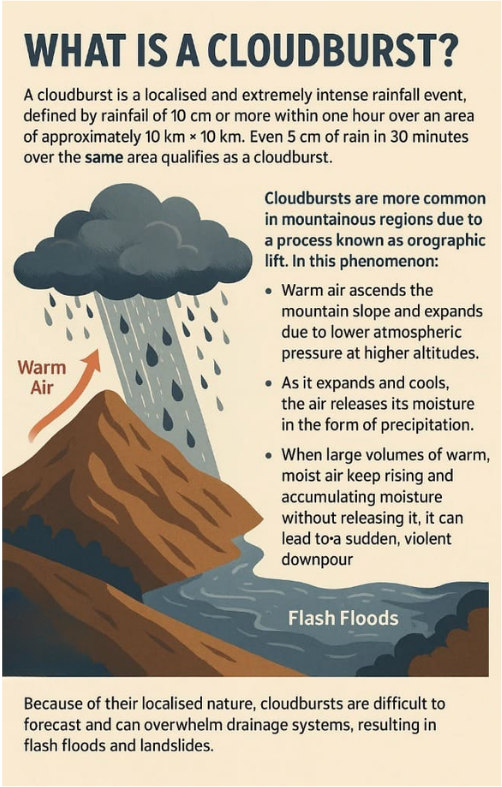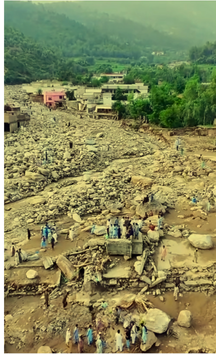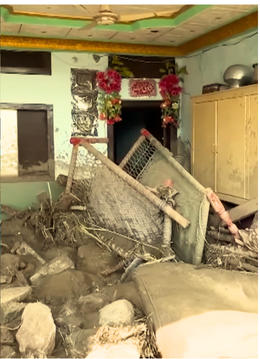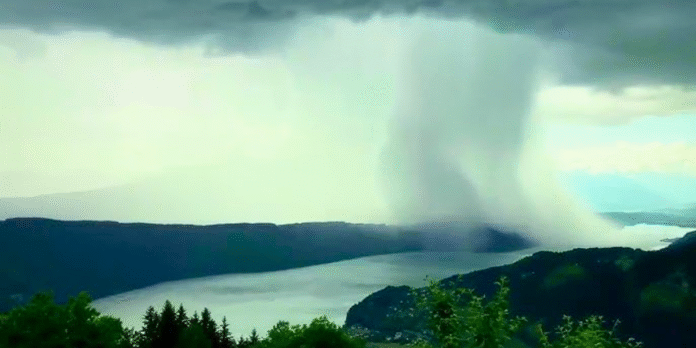When the sky opens without warning, Pakistan pays the price. A gripping look at how climate change and lost forests turn rain into ruin
A cloudburst is nature’s most violent act of sudden release, a torrential downpour compressed into minutes rather than hours. It is not rain as we know it, but a sky splitting open, hur- ling water onto the earth with such force that rivers are born where none existed, and hill- sides dissolve into deadly floods. Unlike gentle showers that nourish life, a cloudburst deva-states it, tearing away soil, uprooting trees, drowning villages, and sweeping lives in its torrent.
Science tells us that cloudbursts occur when warm, moisture-laden air is forced rapidly upward, condensing into massive clouds that can no longer hold their burden. But behind the science lies a deeper warning. As the planet warms, as deforestation strips away natural buffers, and as we carelessly carve mountains and cities without respect for their rhythms, we invite more of these catastrophic events.
A cloudburst is a message from the atmosphere itself, a reminder of the fragile balance between air, water, and earth. In its fury lies a truth Rachel Carson once made clear: when we alter nature without reverence, nature answers in kind. And her answers, as in the case of a cloudburst, are always louder than our denial.
Cloudbursts in Pakistan are the result of a mix of natural geography and human-driven climate change. Let me explain in a way that connects both science and environmental reality:

1. Geographic and Climatic Factors
Pakistan’s northern regions, Gilgit Baltistan, Khyber Pakhtunkhwa, and Kashmir, are mountainous, with steep valleys and fragile soils. In summer, monsoon winds push warm, moisture-laden air from the Arabian Sea and Bay of Bengal into these mountains. When this moist air collides with cooler currents at high altitudes, it rises sharply and condenses into dense thunder clouds. If the cloud cannot hold its water load, it bursts suddenly, unleashing torrential rain in a small area within minutes.
2. Climate Change Intensification
Global warming has supercharged the water cycle. Warmer air holds more moisture, meaning clouds can carry heavier loads before they collapse. In Pakistan, where glaciers are also melting, the atm- osphere is primed for sudden, violent downpours. Studies show that extreme rainfall events in South Asia have increased in frequency and severity due to rising global temperatures.
Story: On social media, a haunting video has surfaced: an elderly man, drenched and breathless, running through the floodwaters as someone films him from behind. His voice breaks into a desperate cry: “This is why we pleaded with everyone not to sell their lands to outsiders. Look at what has happened: every tree has been felled, the forests stripped away. Timber logging has unleashed these floods upon us.”




3. Deforestation and Land Use
The loss of forests in Pakistan’s mountains reduces the land’s natural sponge-like capacity to absorb water. With bare soil and unplanned construction on fragile slopes, rainwater rushes down unchecked, amplifying floods and landslides triggered by cloudbursts.
4. Human Settlements in Hazard Zones
Many communities live along riverbanks and steep valleys, areas most vulnerable to flash floods. When a cloudburst strikes, there is little time to warn or evacuate, turning a natural event into a humanitarian disaster.
Pakistan is vulnerable to cloudbursts because of its unique geography, but climate change and environmental mismanagement are making them deadlier.
Cloudburst Disasters in 2025: The Human Toll
This year, 2025, Pakistan has suffered one of its most chaotic monsoon seasons yet. According to the Provincial Disaster Management Authority (PDMA), more than 1,000 people have died across Khyber Pakhtunkhwa (KP) and northern Pakistan due to floods and cloud bursts. Thousands remain missing as rescue operations continue.
Buner District: The worst hit area, with 222 deaths and 120 injuries. Villages were buried under walls of mud, stones, and floodwater.
Shangla & Mansehra: Together reported nearly 60 deaths, with schools and homes destroyed.
Swat: At least 20 deaths and severe damage to over 220 houses and livestock losses.
Swabi (Gadoon Amazai): A direct cloudburst killed 11 people in Dalori village, including children and women. Twelve houses were inundated, and many were swept away before dawn.
In Gilgit, Baltistan, the GBDMA reported 45 deaths since late June, with nearly 1,000 houses damaged and 87 bridges washed away, cutting off entire valleys from relief.
Government Response and Relief Efforts
It was officially announced on 18 August 2025, KP’s PDMA released Rs800 million in relief funds, with Rs500 million earmarked for Buner alone. Over 425 relief camps have been set up nationwide, offering shelter, food, and medical care. The Pakistan Army has deployed units for rescue missions, airlifting critically injured individuals from remote villages.
Despite these efforts, survivors continue to plead for excavators, medicines, and long-term rehabilitation. Many families remain buried under rubble in inaccessible mountain terrain. This catastrophe pattern is not new. From the Indus floods of 2010 to the cloudbursts of recent years, Pakistan’s disasters repeat themselves with almost rhythmic cruelty. If history teaches us anything, it is this: climate disasters in Pakistan are not episodic; they are cumulative. Without sustained investment, transparent delivery of funds, and recognition of Pakistan’s role as a frontline climate victim, these floods will continue to be not only natural phenomena but also human-made failures.

World Reacts to Pakistan’s Flood Disaster
From New York to Geneva, the response has been one of urgency, sympathy, and calls for action.
At the United Nations, officials described the tragedy as a “climate catastrophe”, underscoring how Pakistan contributes less than one percent of global emissions yet bears a disproportionate share of climate disasters. UN Secretary General António Guterres urged the international community to “stand with Pakistan in its hour of need,” calling for expanded relief aid and long-term investment in climate resilience.
In Washington, the U.S. pledged millions in emergency assistance, while European leaders emphasized both humanitarian aid and the importance of climate justice. China and Gulf states announced the dispatch of food, tents, and medical teams, reinforcing regional solidarity. Aid agencies, including the Red Cross and Médecins Sans Frontières, have mobilized to reach remote areas where flash floods cut off entire communities.
But beyond pledges and statements, there is a familiar question: Will compassion translate into lasting commitment? Many in Pakistan remember the promises made after the 2022 floods, when billions were pledged but only a fraction disbursed. That year, international donors promised over $9 billion at a Geneva conference for “resilient recovery.” Yet, by many accounts, less than half of that has translated into actual disbursements. For now, the world’s words echo with concern, but Pakistan’s future depends on whether those words are matched by action.

Economic Impact
Economic experts warn that the deluge has undone years of fragile progress. Roads, railways, and power grids lie crippled in several provinces, cutting off not just commu- nities but also supply chains vital to the national economy. Schools and hospitals, already stretched thin, are sub- merged or rendered unusable. Beyond bridges, it is the collapse of this connective tissue that threatens to keep millions isolated from recovery for months to come.
Perhaps most alarming is the hit to agriculture. Pakistan’s breadbasket regions, Punjab’s wheat fields, Sindh’s rice paddies, and orchards in Khyber Pakhtunkhwa, have been inundated. Livestock losses are mounting, while stored grain has spoiled in floodwaters. For a country where farming sustains nearly 40% of the population, the implications are stark: higher food insecurity, inflationary pressure, and long-term income loss for rural families.
Without it, a climate hit economy already on fragile ground could find itself sinking deeper leaving not just Pakistan, but the world’s food and climate security, at risk.
Final Thoughts
Each monsoon now feels less like a season and more like a reckoning. Cloudbursts in Pakistan are not isolated tempests; they are the visible scars of a planet pushed beyond balance and a country caught at the frontlines of a global crisis it did little to create.
The challenge ahead is twofold. Pakistan must treat climate resilience not as a distant ambition but as an immediate priority reforesting mountains, regulating reckless development, and ensuring that relief funds reach those who have lost everything. At the same time, the international community must honor its pledges with urgency and honesty, recognizing that solidarity is measured not in promises but in delivery.
If the past decade has shown us anything, it is that neglect and delay only deepen the wounds. The floods of 2025 cannot become another forgotten chapter. This time, compassion must be matched by commitment, and promises by action.
The author can be contacted babargorsi@gmail.com






